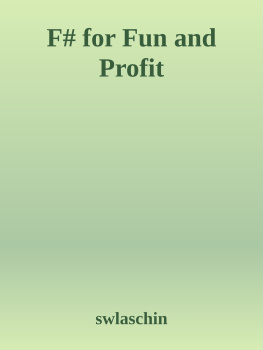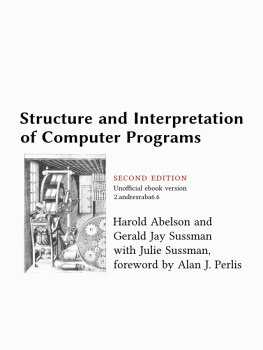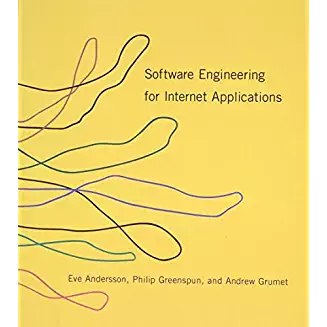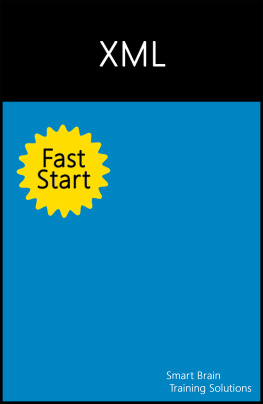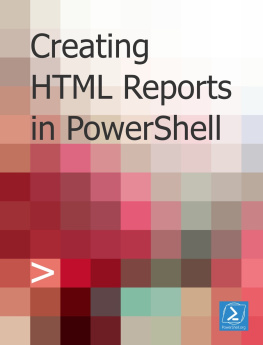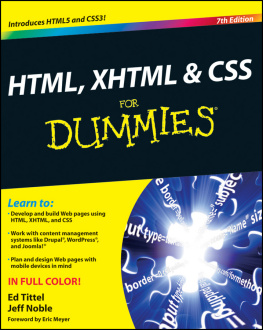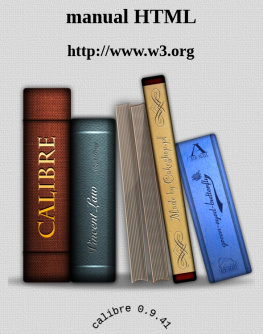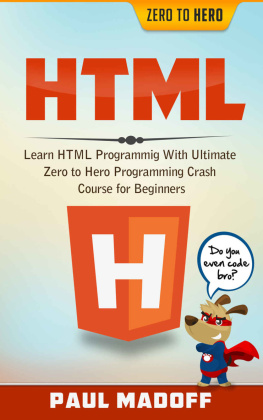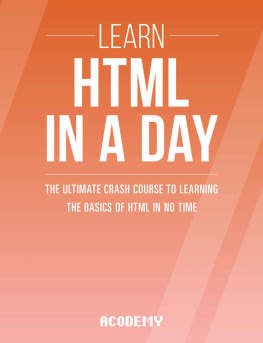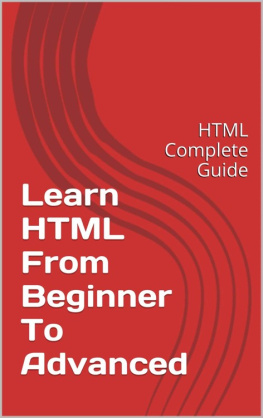it-ebooks - HTML 5.1 Specification
Here you can read online it-ebooks - HTML 5.1 Specification full text of the book (entire story) in english for free. Download pdf and epub, get meaning, cover and reviews about this ebook. year: 2016, publisher: iBooker it-ebooks, genre: Computer. Description of the work, (preface) as well as reviews are available. Best literature library LitArk.com created for fans of good reading and offers a wide selection of genres:
Romance novel
Science fiction
Adventure
Detective
Science
History
Home and family
Prose
Art
Politics
Computer
Non-fiction
Religion
Business
Children
Humor
Choose a favorite category and find really read worthwhile books. Enjoy immersion in the world of imagination, feel the emotions of the characters or learn something new for yourself, make an fascinating discovery.

HTML 5.1 Specification: summary, description and annotation
We offer to read an annotation, description, summary or preface (depends on what the author of the book "HTML 5.1 Specification" wrote himself). If you haven't found the necessary information about the book — write in the comments, we will try to find it.
HTML 5.1 Specification — read online for free the complete book (whole text) full work
Below is the text of the book, divided by pages. System saving the place of the last page read, allows you to conveniently read the book "HTML 5.1 Specification" online for free, without having to search again every time where you left off. Put a bookmark, and you can go to the page where you finished reading at any time.
Font size:
Interval:
Bookmark:

Copyright ? 2016 W3C? (MIT, ERCIM, Keio, Beihang). W3C liability, trademark and permissive document license rules apply.
This specification defines the 5th major version, first minor revision of the corelanguage of the World Wide Web: the Hypertext Markup Language (HTML). In this version,new features continue to be introduced to help Web application authors, new elementscontinue to be introduced based on research into prevailing authoring practices, andspecial attention continues to be given to defining clear conformance criteria for useragents in an effort to improve interoperability.
This section describes the status of this document at the time of its publication. Other documents may supersede this document. A list of current W3C publications and the latest revision of this technical report can be found in the W3C technical reports index at https://www.w3.org/TR/.
This is a Proposed Recommendation for HTML 5.1 that would obsolete theHTML 5.0 Recommendation. AnHTML 5.1 Candidate Recommendationwas published on 21 June 2016, and this document has incorporated feedback received on that draft.
W3C Advisory Committee members are invited to advise the Director on whether this document shouldbecome a W3C Recommendation through the relevant questionnaire in their WBS questionnaires, before 13 October 2016.
Errata for this document are recorded as issues. The latest HTML editors' draft shows the current proposed resolution of errata in situ.
All interested parties are invited to provide implementation and bug reports and other comments throughthe Working Group's Issue tracker. These will generally be considered in the development of HTML 5.2.
The implementation report produced for this version demonstrates that in almost every case changes are matched by interoperable implementation.In the instances where there is not yet interoperable implementation, there are warnings explicitly pointing this out:
Matching for the This is implemented in Firefox. It cannot be tested directly without a matching implementation of the CSS selector itself. It is not an HTML feature per se, it is a description that matches the CSS selector to HTML's directionality algorithm.Unhandled promise rejection and {{rejectionhandled}}This feature has been partially implemented in Blink. Promises are becoming an integral part of the Web Platform, and this was adopted for consistency with WHATWG.MakingcreateTFoot() insert at the end of a tableThis is currently implemented in Firefox. There is poor interoperabiity in this area, but this is a desirable behaviour, and provides consistency with WHATWG.probablySupportsContext() for <{canvas}>This is a convenience function meant to return false if called on a canvas that definitely doesn't support the relevant context, and true otherwise. It is not currently known to be implemented in any browser.The close() method for blobs, and hooks added for CSP 3 blocking styles and eventsThe places where these are mentioned are in algorithms. If they are not implemented, there is no problem caused as the algorithm continues to work as expected. Of the items marked "at risk" in theCandidate Recommendation, the followinghave been removed:
- The
dialogelement - The
registerContentHandler(),isContentHandlerRegistered()andisProtocolHandlerRegistered()methods - The
datetimevalue for thetypeattribute of theinputelement - unimplemented parts of the autofill mechanism
- The
labelelement is no longer Reassociatable - the
toolbartype for themenuelement - the
inputmodeattribute
The remaining items were retained:
- the remainder of autocomplete
- The
menuandmenuitemelements with thecontextmenutype - The
datetime-localvalue for thetypeattribute of theinputelement - the use of text tracks to expose in-band metadata
- The
keygenelement
The Working Group aims to recharter at the end of October, and to produce an HTML 5.2 Recommendationin late 2017 that would obsolete the HTML 5.1 Recommendation it aims to publish in late 2016based on this draft.
This document was published by the Web Platform Working Group as a Proposed Recommendation. This document is intended to become a W3C Recommendation. Feedback and comments on this specification are welcome. Please use Github issues. Historical discussions can be found in the public-html@w3.org archives.
Publication as a Proposed Recommendation does not imply endorsement by the W3C Membership. This is a draft document and may be updated, replaced or obsoleted by other documents at any time. It is inappropriate to cite this document as other than work in progress.
This document was produced by a group operating under the 5 February 2004 W3C Patent Policy. W3C maintains a public list of any patent disclosures made in connection with the deliverables of the group; that page also includes instructions for disclosing a patent. An individual who has actual knowledge of a patent which the individual believes contains Essential Claim(s) must disclose the information in accordance with section 6 of the W3C Patent Policy.
This document is governed by the 1 September 2015 W3C Process Document.
This section is non-normative.
HTML is the World Wide Webs core markup language. Originally, HTML was primarily designed as a language for semantically describing scientific documents. Its general design, however, has enabled it to be adapted, over the subsequent years, to describe a number of other types of documents and even applications.
This section is non-normative.
This specification is intended for authors of documents and scripts that use the features defined in this specification, implementors of tools that operate on pages that use the features defined in this specification, and individuals wishing to establish the correctness of documents or implementations with respect to the requirements of this specification.
This document is probably not suited to readers who do not already have at least a passing familiarity with Web technologies, as in places it sacrifices clarity for precision, and brevity for completeness. More approachable tutorials and authoring guides can provide a gentler introduction to the topic.
In particular, familiarity with the basics of DOM is necessary for a complete understanding of some of the more technical parts of this specification. An understanding of Web IDL, HTTP, XML, Unicode, character encodings, JavaScript, and CSS will also be helpful in places but is not essential.
This section is non-normative.
This specification is limited to providing a semantic-level markup language and associated semantic-level scripting APIs for authoring accessible pages on the Web ranging from static documents to dynamic applications.
Next pageFont size:
Interval:
Bookmark:
Similar books «HTML 5.1 Specification»
Look at similar books to HTML 5.1 Specification. We have selected literature similar in name and meaning in the hope of providing readers with more options to find new, interesting, not yet read works.
Discussion, reviews of the book HTML 5.1 Specification and just readers' own opinions. Leave your comments, write what you think about the work, its meaning or the main characters. Specify what exactly you liked and what you didn't like, and why you think so.

